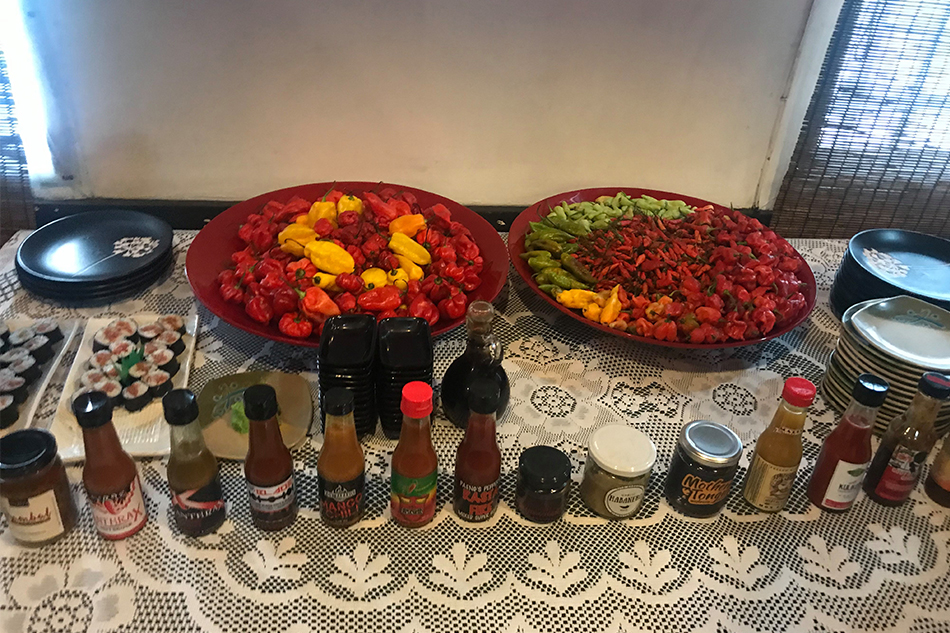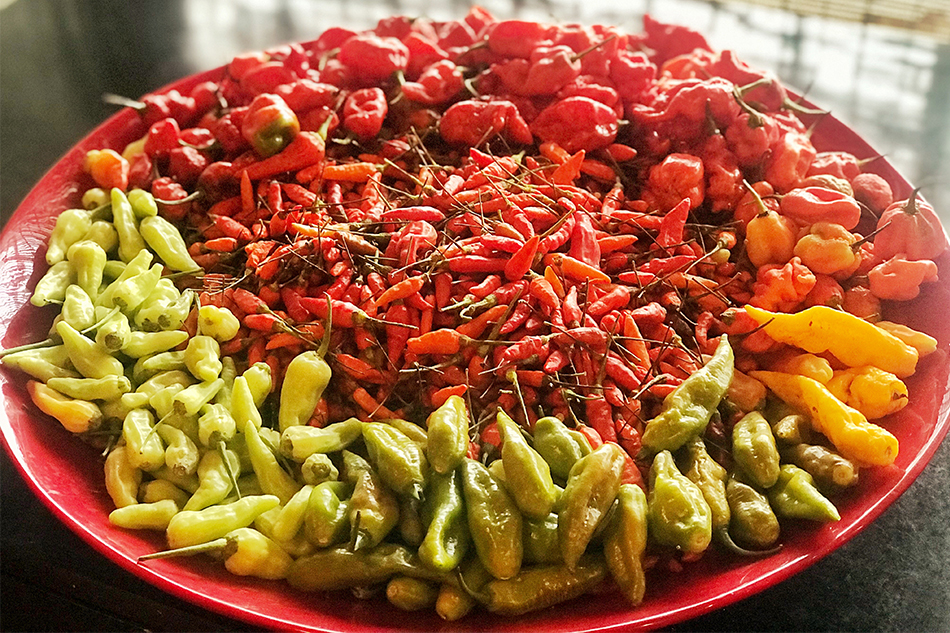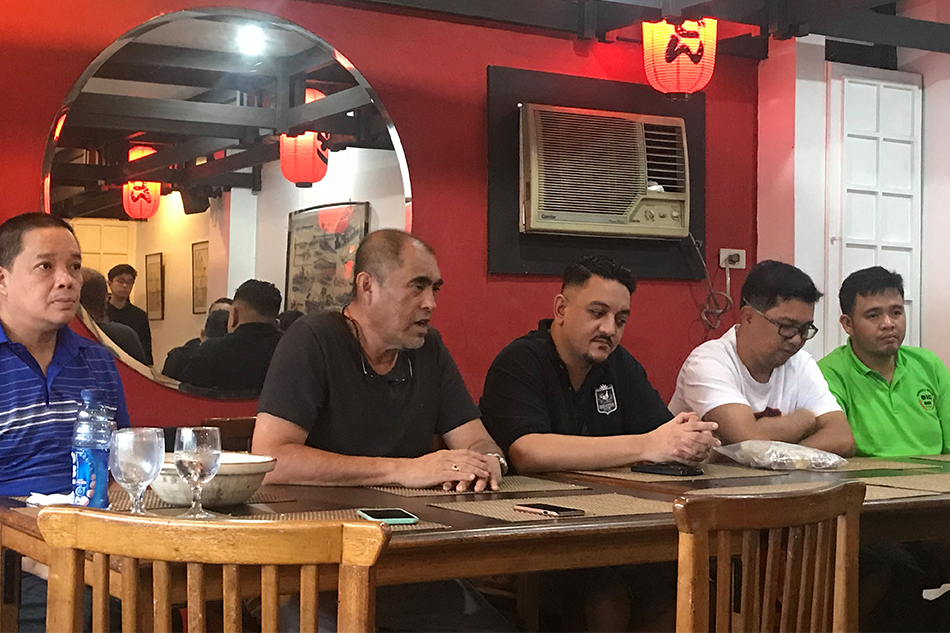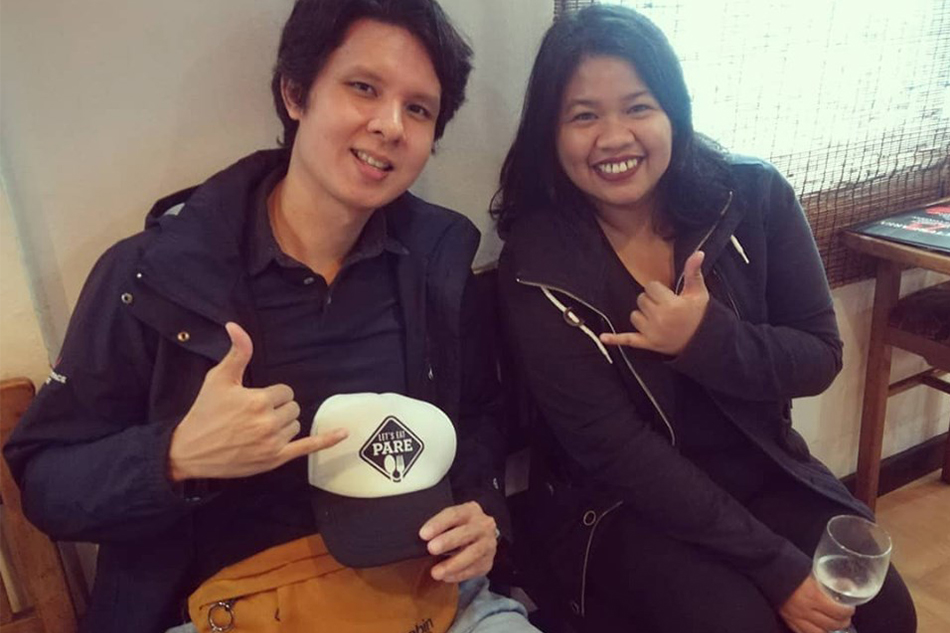Can a Pinoy hot sauce become the next sriracha? One chili maker is betting on it | ABS-CBN
ADVERTISEMENT

Welcome, Kapamilya! We use cookies to improve your browsing experience. Continuing to use this site means you agree to our use of cookies. Tell me more!
Can a Pinoy hot sauce become the next sriracha? One chili maker is betting on it
Can a Pinoy hot sauce become the next sriracha? One chili maker is betting on it
Bam V. Abellon
Published Aug 16, 2019 02:41 PM PHT
|
Updated Aug 16, 2019 02:51 PM PHT
Miguel “Miggy” Esguerra uttered the words “goose bumps” three times during the course of our interview. Our topic revolved mostly around chilies, on which he has become a self-made expert. It’s accurate to say, then, that the owner of local hot sauce brand Miggy’s Pepper lets go of his usual chill when he talks about chilies. In fact, his enthusiasm is almost as piquant as the products he’s selling. And that—getting people to be as excited as he is about a proverbial sauce—is actually one of his goals.
Miguel “Miggy” Esguerra uttered the words “goose bumps” three times during the course of our interview. Our topic revolved mostly around chilies, on which he has become a self-made expert. It’s accurate to say, then, that the owner of local hot sauce brand Miggy’s Pepper lets go of his usual chill when he talks about chilies. In fact, his enthusiasm is almost as piquant as the products he’s selling. And that—getting people to be as excited as he is about a proverbial sauce—is actually one of his goals.
“The Philippines produces a lot of sili,” the 29-year-old entrepreneur says. “Let’s make something out of that.”
“The Philippines produces a lot of sili,” the 29-year-old entrepreneur says. “Let’s make something out of that.”
You may also like:
You may also like:
From urban farming to selling hot sauce
From urban farming to selling hot sauce
Before Miggy’s Pepper was born three years ago, Esguerra had never run a serious business, nor had he been interested in chilies. “I can eat without it,” he tells ANCX. He is, however, a man who dabbles in various pursuits: playing the guitar, making music, cooking. Often, he watches cooking videos online and tries out recipes for the sake of fun.
Before Miggy’s Pepper was born three years ago, Esguerra had never run a serious business, nor had he been interested in chilies. “I can eat without it,” he tells ANCX. He is, however, a man who dabbles in various pursuits: playing the guitar, making music, cooking. Often, he watches cooking videos online and tries out recipes for the sake of fun.
Then, three years ago, a craving took him down an unplanned path. One day, he wanted to buy pepper at the nearby market—just to add flavor to his regular meal. “Na-frustrate ako,” he recalls. “It was expensive and hindi maganda.”
Then, three years ago, a craving took him down an unplanned path. One day, he wanted to buy pepper at the nearby market—just to add flavor to his regular meal. “Na-frustrate ako,” he recalls. “It was expensive and hindi maganda.”
ADVERTISEMENT
That day, he decided, “I’ll just plant pepper at my own house. Pipitas lang ako, hindi ko naman kailangan nang marami.” However, he soon found out that his home in Quezon City wouldn’t be an ideal place to plant pepper seeds because of the temperature. And he also needed to buy soil because all paths around him were paved. When he dug deeper into the subject, he read that he can, indeed, plant pepper—but the seeds have to be from varieties that he had never heard of.
That day, he decided, “I’ll just plant pepper at my own house. Pipitas lang ako, hindi ko naman kailangan nang marami.” However, he soon found out that his home in Quezon City wouldn’t be an ideal place to plant pepper seeds because of the temperature. And he also needed to buy soil because all paths around him were paved. When he dug deeper into the subject, he read that he can, indeed, plant pepper—but the seeds have to be from varieties that he had never heard of.
After days of reading pages of his newfound interest, Esguerra came across a name: Philippine Chili Foundation (PCF). One may call them a governing body of some sort when it comes to anything related to chili in the country. The group aims to raise awareness of the current situation in the chili industry, which includes concerns regarding chili farmers. They also organize activities that support their causes, such as frequent meet-ups, where they also discuss different varieties of pepper that can be cultivated in the country. Once in a while, they organize bazaars where members can sell their products.
After days of reading pages of his newfound interest, Esguerra came across a name: Philippine Chili Foundation (PCF). One may call them a governing body of some sort when it comes to anything related to chili in the country. The group aims to raise awareness of the current situation in the chili industry, which includes concerns regarding chili farmers. They also organize activities that support their causes, such as frequent meet-ups, where they also discuss different varieties of pepper that can be cultivated in the country. Once in a while, they organize bazaars where members can sell their products.
On their official Facebook page, Philippine Chili Federation PCF, they wrote, “Kailangan namin ay mga miyembro na mahilig sa pagsisili.” The page administrators also vet people who want to become members of the group: if a Facebook account had no trace of any activity related to chili, then his or her membership might be denied. It’s serious business, really.
On their official Facebook page, Philippine Chili Federation PCF, they wrote, “Kailangan namin ay mga miyembro na mahilig sa pagsisili.” The page administrators also vet people who want to become members of the group: if a Facebook account had no trace of any activity related to chili, then his or her membership might be denied. It’s serious business, really.
Soon, Esguerra joined the federation and got hooked into the then-little community. He found out, through online reading and with the help of the PCF members, where he could source this certain variety of chili pepper called yellow habanero. He had read about this variety in some recipes, but he had never tasted it.
Soon, Esguerra joined the federation and got hooked into the then-little community. He found out, through online reading and with the help of the PCF members, where he could source this certain variety of chili pepper called yellow habanero. He had read about this variety in some recipes, but he had never tasted it.
The eager student contacted the suggested seller online, but they only allowed a minimum order of three kilos. The original plan was just to pluck out the seeds and plant them in vermicast (a pepper-friendly soil from earthworm manure). Esguerra went for it.
The eager student contacted the suggested seller online, but they only allowed a minimum order of three kilos. The original plan was just to pluck out the seeds and plant them in vermicast (a pepper-friendly soil from earthworm manure). Esguerra went for it.
ADVERTISEMENT
When his order arrived, he was astounded. “Ang dami!” the long-haired, impassioned guy recalls. “What am I gonna do with the sili? Mabubulok lang,” he wonders.
When his order arrived, he was astounded. “Ang dami!” the long-haired, impassioned guy recalls. “What am I gonna do with the sili? Mabubulok lang,” he wonders.
And then, he experienced what he describes as a eureka moment. That’s the solution, he figures, “Pabubulukin ko na lang.” The idea was to preserve the produce through fermentation. Again, he sat in front of his computer for hours reading every article he could possibly find about the subject.
And then, he experienced what he describes as a eureka moment. That’s the solution, he figures, “Pabubulukin ko na lang.” The idea was to preserve the produce through fermentation. Again, he sat in front of his computer for hours reading every article he could possibly find about the subject.
He learned that it was a long and tedious process. But the always-curious business process outsourcing (BPO) employee gave it a go. He bought three two-liter mason jars with metal lids, where he submerged the peppers in water. Every day, he had to “burp” the jars to release the carbon dioxide from the bacteria—or the jars could break due to pressure.
He learned that it was a long and tedious process. But the always-curious business process outsourcing (BPO) employee gave it a go. He bought three two-liter mason jars with metal lids, where he submerged the peppers in water. Every day, he had to “burp” the jars to release the carbon dioxide from the bacteria—or the jars could break due to pressure.
Then, while he was in the middle of his “experiment,” he came across a recipe with included pepper fermentation as the initial step in making hot sauce. The recipe also had mangoes as one of the main ingredients. “Philippines has the best mangoes in the world, so I thought, this could work,” Esguerra says.
Then, while he was in the middle of his “experiment,” he came across a recipe with included pepper fermentation as the initial step in making hot sauce. The recipe also had mangoes as one of the main ingredients. “Philippines has the best mangoes in the world, so I thought, this could work,” Esguerra says.
After three to four weeks, he removed the fermented chili from the jars and boiled them. He added garlic, onions, and mangoes, to name a few. Then, he puréed all ingredients in a blender. The end-product—which, according to Esguerra, looked like a yellow smoothie—had a complex, mild to moderately hot flavor. The combination of fruity, citrusy, and floral flavors from the yellow habanero; the tangy spices; and the sweet mangoes was heaven to his palate.
After three to four weeks, he removed the fermented chili from the jars and boiled them. He added garlic, onions, and mangoes, to name a few. Then, he puréed all ingredients in a blender. The end-product—which, according to Esguerra, looked like a yellow smoothie—had a complex, mild to moderately hot flavor. The combination of fruity, citrusy, and floral flavors from the yellow habanero; the tangy spices; and the sweet mangoes was heaven to his palate.
ADVERTISEMENT
Proud of what he made, he put this creation in clean, sterilized bottles he bought in Manila, and brought one bottle—and nacho chips—to his office. His colleagues immediately raved about his hot sauce, and persuaded him to sell his creation.
Proud of what he made, he put this creation in clean, sterilized bottles he bought in Manila, and brought one bottle—and nacho chips—to his office. His colleagues immediately raved about his hot sauce, and persuaded him to sell his creation.
“I have so many hobbies,” he says. “I thought, why not make this one a source of additional income?”
“I have so many hobbies,” he says. “I thought, why not make this one a source of additional income?”
The first product under Miggy’s Pepper was called the “Firesauce,” the one that started it all. Now, the brand also carries another variety of hot sauce called “Smoked,” and a rub (with dried chili as its main ingredient) called “Voodoo.” Esguerra sells around 48 bottles a month—or more, when he gives in to the requests of friends and relatives.
The first product under Miggy’s Pepper was called the “Firesauce,” the one that started it all. Now, the brand also carries another variety of hot sauce called “Smoked,” and a rub (with dried chili as its main ingredient) called “Voodoo.” Esguerra sells around 48 bottles a month—or more, when he gives in to the requests of friends and relatives.
Chili for everyone
Chili for everyone
Esguerra likes to keep everything low-key and low-tech, even with his growing followers. The purpose of which, he says, is to make it easy for people to follow his lead. His only assistant is his father, his lone housemate. And he does everything by hand and by the book—he read all the Food and Drug Administration (FDA) requirements before he sold his products.
Esguerra likes to keep everything low-key and low-tech, even with his growing followers. The purpose of which, he says, is to make it easy for people to follow his lead. His only assistant is his father, his lone housemate. And he does everything by hand and by the book—he read all the Food and Drug Administration (FDA) requirements before he sold his products.
He tells us, “I want to help people who are at home, who are trying to experiment and make things. I want to help them package their products, create their brand. Maybe I can help them start something.”
He tells us, “I want to help people who are at home, who are trying to experiment and make things. I want to help them package their products, create their brand. Maybe I can help them start something.”
ADVERTISEMENT
It is for this reason that Esguerra, who is also a member of the Philippine Hot Sauce Club, is excited for another pursuit that he will be doing for the first time by the end of August.
It is for this reason that Esguerra, who is also a member of the Philippine Hot Sauce Club, is excited for another pursuit that he will be doing for the first time by the end of August.
On August 25, at Whitespace Manila in Makati City, Esguerra will be one of the speakers at the 6th Philippine Chili Festival called “Chili Explosion.” Joining him on the roster are potted plant grower Vic Chin and chili guru Johnny Scoville, who will fly in from the United States.
On August 25, at Whitespace Manila in Makati City, Esguerra will be one of the speakers at the 6th Philippine Chili Festival called “Chili Explosion.” Joining him on the roster are potted plant grower Vic Chin and chili guru Johnny Scoville, who will fly in from the United States.
The Philippine Chili Festival has grown tremendously since its inception in 2014, where it was held at a small gastro pub. The activities, too, have become more and more exciting. This year, they will have a hot sauce competition, hot sauce tasting, chili plant contest, seed sharing, and insightful lectures, to name a few.
The Philippine Chili Festival has grown tremendously since its inception in 2014, where it was held at a small gastro pub. The activities, too, have become more and more exciting. This year, they will have a hot sauce competition, hot sauce tasting, chili plant contest, seed sharing, and insightful lectures, to name a few.
Other than making people aware of his brand, Esguerra sees this speaking engagement as an opportunity to teach what he knows to an interested audience. “I want to develop the process even more,” he says. “I want to make it easier for people to make their own products. I’m not selfish. When people ask me how I make my hot sauce, I tell them.” He is also in the process of writing a handbook, which he plans to distribute to the participants.
Other than making people aware of his brand, Esguerra sees this speaking engagement as an opportunity to teach what he knows to an interested audience. “I want to develop the process even more,” he says. “I want to make it easier for people to make their own products. I’m not selfish. When people ask me how I make my hot sauce, I tell them.” He is also in the process of writing a handbook, which he plans to distribute to the participants.
In the future, he wants to help teach the chili farmers ways in which they can preserve and make use of unsold produce. “That’s also one of my goals: reduce food waste.”
In the future, he wants to help teach the chili farmers ways in which they can preserve and make use of unsold produce. “That’s also one of my goals: reduce food waste.”
ADVERTISEMENT
Esguerra’s greatest hope is for the chili industry to receive the attention it deserves. In a country that is obsessed with spicy food, he sees no reason why it couldn’t happen. He says, “Hindi natin alam, we could make the next sriracha or Tabasco. We can provide something new, something to explore. And besides, food really tastes better with sauce.”
Esguerra’s greatest hope is for the chili industry to receive the attention it deserves. In a country that is obsessed with spicy food, he sees no reason why it couldn’t happen. He says, “Hindi natin alam, we could make the next sriracha or Tabasco. We can provide something new, something to explore. And besides, food really tastes better with sauce.”
The Philippine Chili Festival happens Sunday, August 25, 2019 at Whitespace, 2314 Chino Roces Avenue Extension, Makati City, from 8 am to 8 pm with an entrance fee of P200. Visit Philippine Chili Federation PCF on Facebook.
Read More:
ancx
anc-x
ancx.ph
anc
abs-cbn
food and drink
features
chili explosion
Chili Festival
Miggy Esguerra
ADVERTISEMENT
ADVERTISEMENT







